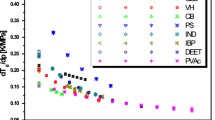Summary
In 1933 Ehren/est defined transitions in which not only the thermodynamical potential but also the specific volume and entropy of the two states are equal. For these transitions he derived three relations, between the differences of the coefficients of dilatation and of compressibility and the specific heat on one hand and the slope of the transition curve in /)-T-space on the other hand.
Although it is beyond any doubt that the glass-rubber transition in polymers is not a second order transition as defined by Ehren]est, yet the term “second order transition” is often applied to it.
The confusion arising from this abuse of a physically well defined eonce]?t is enhanced by the fact that some of Ehren/est's relations are under certain circumstances valid for the glass ∶ rubber transition, although in those cases the physical background of these relations is quite different from that of a second order transition in Ehren/est's sense. In fact, the essence of the glass transition has been formulated clearly and correctly by Simon in 1931 and consists in the assumption that in a glass one or more internal parameters are not in equilibrium but are frozen in.
The conditions required for the validity of each of EhrenJest's relations are inspected. The equality of two functions of the dilatation and the compressibility coefficients and the specific heats of the two states depends on the condition that there is only one frozen parameter in the glass state. I f there is more than one fl'ozen parameter, then the equality turns into an inequality and the physical meaning of the difference between the two sides is derived.
Similar relations as those derived between the quantities mentioned, can be derived between the specific heat, the modulus of elasticity and the temperature coefficient of that modulus. These new relations are more interesting for practical purposes and less subject to experimental errors than the older ones.
Finally the expressions for the slope of the transition curve are investigated. The validity of any one of the expressions depends on the physical condition required for a material to become a glass. Reversely from the validity of any of the possible expressions insight in the glass transformation can be derived. The scarce available data give the impression that a material turns into a glass whenever its excess entropy decreases below a critical value.
Similar content being viewed by others
References
Ehrenfest, P., Commun. Kamerlingh Onnes Lab. University Leiden, Suppl. 75b (1933) Proc. Kon. Akad. Amsterdam36, 153 (1933).
Prigogine, I. andDefay, R., Thermodynamique chimique, chap. XIX, Liège 1950 p. 308.
Davies, R. O., “Changement de Phases”, Paris 1952, p. 425.
Davies, R. O., Advances in Phys.2, 370 (1953).
Davies, R. O. andG. O. Jones, Proc. Roy. Soc.217 A, 26 (1953).
Meixner, J., Z. Naturforschung9 a, 654 (1954).
de Donder, Th., “l'Affinité”, Paris 1936, chap. V–IX.
Tammann, G., „Der Glaszustand“, (Leipzig 1933)
Goldstein, M., J. Chem. Phys.39, 3369 (1963).
O'Reilly, J. M., J. Polymer Sci.57, 429 (1962).
Kovacs, A. J., Adv. Pol. Sci.3, 408 (1964).
Gibbs, J. H., in “The Vitreous State” ed.Mackenzie (London 1960). J. Chem. Phys.25, 185 (1956). withDiMarzio, J. Chem. Phys.28, 373, 807 (1958). J. Polymer Sci.40, 121 (1959);A 1, 1417 (1963).
Author information
Authors and Affiliations
Rights and permissions
About this article
Cite this article
Staverman, A.J. Thermodynamic aspects of the glass-rubber transition. Rheol Acta 5, 283–292 (1966). https://doi.org/10.1007/BF02009736
Received:
Issue Date:
DOI: https://doi.org/10.1007/BF02009736



